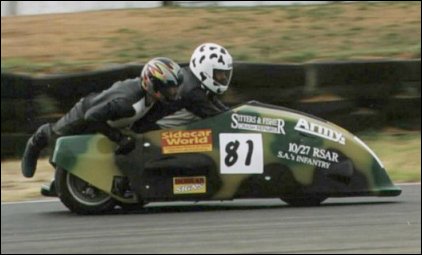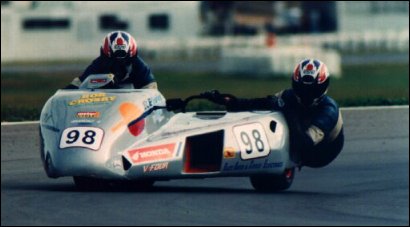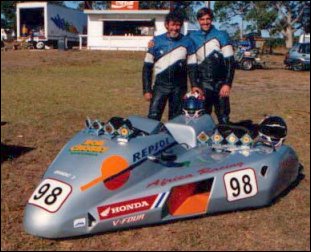| Racing In Australia |
| There are a few differences between racing in the UK and Australia.In the UK
for example you can go racing just about every weekend if you want, as there
are many venues offering racing at all levels, while here in Aussie we only
have a very small number of suitable tracks on which we have to fight for
for space with the cars, (who always have priority over bikes I must
add). The average Aussie racer would be lucky if he races at more than 10
or 12 meetings a year. Most of these would be local club events or State
events, with maybe one or two trips interstate per year to do a major
meeting. | |||
 | |||
For ease of understanding I'll list them under Sub-Headings. DISTANCE Firstly we do not have the luxury of having a number of race circuits within a few hours driving time. Some of Australia's major cities only have one race track within about 7 or 8 hours driving time.A couple like Sydney and Melbourne have 2 or 3 nearby.Adelaide, Perth, Darwin, for example only have one. To put this into perspective in 1996 I lived in Queensland, and I raced a 125cc GP bike in the National Championships. During the season I raced at the following places, Lakeside Raceway in Queensland, Eastern Creek in New South Wales, Phillip Island in Victoria, Mallala Raceway in South Australia, Baskerville Raceway on the Island State of Tasmania, and finally at Wanneroo Raceway over in Perth Western Australia. Not much I hear you say.....only 6 rounds. But what if I was to tell you that I had to drive over 25 thousand kilometres, no exaggeration,to do those six rounds.I also had to take a total of 8 weeks off of work, all for the privilege of finishing 12th in that years title chase. All of this travel, accounted for two thirds of my race budget as well. Had I not had to travel so far to do the entire National Championship, then I would have been able to afford a newer racebike, more spares, and new tyres at each round. Instead I had to persevere with a 93 model RS 125 Honda, when If I was only racing locally I would have been able to afford a 95 Model. But I wanted to race at the top level, and so I had to make a sacrifice somewhere, and that sacrifice was running an old bike. The mathematics were simple. If I updated my machine, then I would not be able to afford to travel around the country to compete in the Nationals. For example, lets talk about an average Sydney based Aussie road racer who thinks nothing of going down to Phillip Island for a weekend race meeting, he would usually leave on Friday night after work, driving all night to go the 1100 Kilometres to get to the race circuit, snatching a couple of hours sleep in the back of his van, and then having to spend the weekend racing. At the completion of the weekends events, our Sydney based racer has to load up his vehicle, then drive another 12 or 13 hours just to get back home, only to arrive just in time to get up to go to work the next day. I'd be surprised if his boss finds him very productive on Monday morning. That is of course if the racer was lucky enough not to crash and injure himself too badly to drive himself back home. If he was too badly hurt then he would find himself in a bit of a pickle. I know of many motorcycle racers who have lost their jobs in this way.
THE RACE TRACKS Australia does have a couple of race tracks that are good enough to hold International Race events on....namely Phillip Island near Melbourne, and Eastern Creek on the outskirts of Sydney. After that the quality of the other tracks goes down hill quickly.There is a new track at Willowbank in Queensland that is good, and Winton raceway in country Victoria is OK, but other tracks at this country which hold major race meetings, would be considered narrow dangerous goat tracks unworthy of holding even a club event in the UK. To be fair to the circuit owners/operators of these circuits, there is not the money in Australian Racing to update these tracks to a suitable standard for "Top Flight" motorcycle racing, and besides it is Car racing that pays the bills as far as these circuits are concerned. Then we have Bathurst, which Australian Motorcycle racers hold in the sort of awe that is usually reserved for the TT on the Isle of Man. It is a fast, (up to 300 kph for F1 sidecars down Conrod Straight), dangerous race track with no runoff. It is hugely popular with race fans and the general public as well. Unfortunately in the last 10 years or so motorcycle racing has only run at Bathurst about 3 or 4 times, a victim of greedy promoters, and a local council that wants a bigger slice of the income that race meetings such as these can generate. THE WEATHER This is one of the biggest advantages to racing here in Australia.Essentially you can race here all year round, except in Darwin, where it is always too wet to race during the monsoon season, (or "THE WET" as it is known here). Everywhere else in Australia It stays dry most of the time. There a couple of notable exceptions though It only ever seems to rain at Phillip Island when the is a bike meeting on. I'm sure that you all saw the footage from this years SWC. And Mallala Raceway in South Australia it is either blowing a gale, with rain being blown horizontally across the track, or there is a dust storm and the track temperature is up well over 120 degrees Farenheight. More often than not here in Aussie you have to contend with extremes of heat rather than having to deal with the rain and the cold. I have been racing for 17 years now, and I can count the amount of times that I have had to race with wet weather tyres on my race bikes in single figures. Not bad huh.
THE RACING CLASSES There is a bewildering number of race classes available here for all classes from "D Grade" beginners right up to "A Grade" Professionals. But the main Classes are as follows; 600 Super Sport, Lightly modified road going 600s. A very competitive class. 250cc Grand Prix, as the title suggests, 250 GP bikes. This class if in dire danger of dying out grids at National Level are small, with only a few quality riders still bothering to contest this once popular class, usually on older model bikes. 125cc Grand Prix, surprisingly this class still has a strong following here, with many late model machines being piloted be keen young, and not so young hotshots, including a couple of Ex GP regulars. 250cc Production, Absolute carnage is the best way to describe this class, also known as the "Crash and Burn" class. this is the nursery class in Australian Racing. It has produced riders such as the calibre as Mick Doohan, Matt Mladin, Troy Corser, Damon Buckmaster, Karl Muggeridge, Andrew Pitt, and the list continues ad nauseam. these days it is dominated by RS 250 Aprilla road bikes, which are allowed almost no modifications. The class has in the past been ruled by RGV Suzukis, TZR Yamahas, RZ Yamahas, (RDs in the UK), and RG Suzukis. Sidecars nearly vanished off of the face of the earth last year after being dropped from the National Championships. But due to public demand they have made a Lazarus like comeback, (although at 3 rounds of the National Championship only). Sidecars have been, up until this year, F1 only, that is, 1100cc four stroke engines or 500cc two strokes. There is a mix of long and short bikes within F1, roughly on a 50/50 ratio. For the F2, you can have up to 350cc two stroke, or 600cc four stroke engines. F2 sidecars now have their own National Championship class. Races are run concurrently with the National F1s but with separate point scores. There are not many F2s operating here at the moment. most are very, very old short F1 Windle chassised machines which have had more modern 600cc engines put into them. these bikes are old and heavy. there are a couple of purpose built F2 bikes and a couple of F350 Shellbourne outfits racing here at this stage, but it will be a couple of years before we see if this class can get off of the ground. Classic, for Motorcycles and Sidecars of all classes built between 1945 and 1962. this branch of motorsport is slowly dying off due to the fact that these machines are getting harder to find parts for, and the people that were really interested in them now beginning to get too old to race. Post Classic, for motorcycles and sidecars of all classes built between 1963 and 1972. this is the most popular type of racing here in Australia. You will see everything from an exotic Honda CR750s through the Evil handling H2 Kawasakis down to the humble T250 Hustler Suzuki all being raced in their various capacity classes, Sidecars are all front exit outfits mainly being powered by overbored Honda CB750 engines running on methanol. The Post Classic class of racing is so popular because most machines can be built from wreckers yards for next to nothing and raced very cheaply. Forgotten Era, for motorcycles and sidecars of all classes built between 1973 and 1980. Gaining popularity over the last couple of years, this class is the home to big fire breathing GSX 1100 Suzukis, and early TZ 750 Yamahas, and RG500 GP Suzukis. Smaller capacity classes cater for early TZ 250/350 Yamahas, RS 125RW Hondas, Sanrevnos, Morbidellis, and a host of hotted up little road bikes. As yet there is no Forgotten era Sidecar Class, although the regulations allow for one. Formula Extreme, Although not a officially sanctioned championship class, Formula Extreme is for Big four strokes like Yamaha R1s and the new Suzuki GSXR 1000, This class has captured the imagination of the Australian race going public. Formula extreme also has a Naked Bike class for the Big bore "Sports Tourers", such as the XJR 1300. The racing is always interesting with good prize money up for grabs at each round. The whole series is well set up and well supported by the manufacturers. Other Classes, There are a myriad of other classes, but the ones mentioned above are the main ones. You will see that our main classes are similar to what you have over in the UK. SPONSORSHIP Sponsorship, or should I say a lack there of. This is the main reason why motorcycle racing does not enjoy the high profile that it does in the UK. In all classes of Australian racing there is only about 8 or 9 "full time" rides for our top riders to fight over, and as you can appreciate, competition is very intense. The motorcycle industry here is very small, (remember that Australia only has about 17 Million people in total), and as such each of the major factories run one team, usually of about 2 riders each. After that its up to the individual to try and obtain what sponsorship he or she can. The crowds at most of our race meetings are .....ummm err how can I say this ....poor.....very poor. at a recent round of the Australian Championship there were a total of about 500 paying spectators coming through the gate.... that's it. Television coverage is also very minimal, with perhaps two or three Superbike races televised during the year. apart from that, only the GP and the SWC can convince the TV stations to "dust off" their cameras and go and televise a race. There are also so many other sports that vie for the very few sponsorship dollars that are on offer. You seem to find that here in Australia most motorcycle racing sponsors are either in the motorcycle industry, or are motorcycle enthusiasts themselves. WHY ARE THERE SO MANY AUSSIE RACERS IN THE UK AND THE USA The reason that so many of our top racers are in the UK and the USA pinching all of the good rides in these two places is mainly because of the problems outlined in the Paragraph above. there are too few fully paid rides for riders of this calibre here in Australia. Domestic racing in Australia, for all of its lack of money and lack of factory support is a very cutthroat business here. Especially because it is so hard to get a fully sponsored ride. Even if you manage to get one of the few that are on offer, there is no guarantee that you will be able to keep it, as there will always be a horde of talented youngsters who are willing to race for almost nothing who are constantly trying to take your place. This has caused many a talented racer to cast his eyes over to the UK and the US, where there are more fully sponsored rides on offer. CONCLUSION I have never raced in the UK, but a number of UK racers have come over here and made this sunburnt country their home. and in many pit lane conversations, (and Pub sessions too I have to add), they have told me much of the UK racing scene. It's true that there is not a lot of racing that happens here in Australia during the year, but what racing there is, is of the highest quality. It's a tough place to make your mark in, but if you are able to do that here, then you can certainly good enough to do it anywhere. I am actually planning at some time, (finances, and girlfriend willing), to come over to race at the Southern 100, or if I'm brave enough at the TT. Perhaps I'll see you there. John Swensen - johnswensen@ttwebsite.com #81 Defence Force Racing
|

